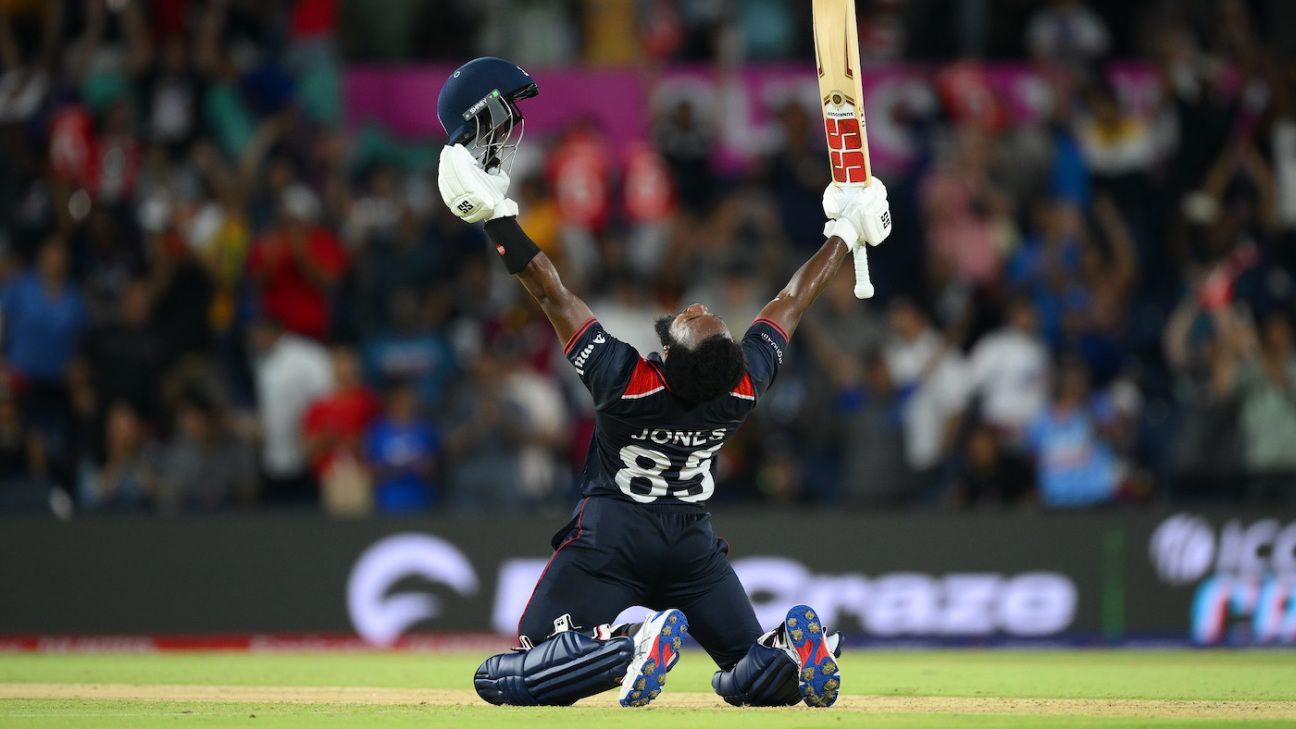Cricket
Aaron Jones gets the big American cricket party started, and how

It was only four days ago that USA Cricket announced an “exclusive ticketing opportunity” where members could buy up to six tickets for 25% off. The game wasn’t a sell-out, clearly, and they were keenly trying to offload tickets to everyone and anyone.
And when ticketing was not the issue, it was the weather. Storms and flash-flood warnings have been ever-present this week in Dallas. Six hours before kick-off, another storm rolled through. Fears of cricket’s big opening night in America being remembered as the evening an empty stadium got rained on were manifesting.
Jones’ 94 not out off 40 deliveries was entirely out of keeping with his career. Arriving at the crease, he had a T20 career strike rate of 104, with 13 sixes in 24 innings. His highest score was 50, his only half-century in the format. But less than an hour later, he left having struck 10 sixes in a match-winning, legacy-defining, innings of history.
Now is the time for hyperbole. The context of this World Cup is whether cricket can work in America. And as Jones smashed sixes on a raucous crowd of 6000 people at the Grand Prairie Stadium in Dallas, and celebrated each one with increasingly dramatic fist pumps, the answer was a resounding yes.
“Sometimes when you play an innings like this,” Jones said after the match. “You go home, you sleep, and then you wake up and go ‘woah, I don’t even know how I batted like that’. It’s happened to me two or three times in the past and I think tomorrow is going to be like that as well.”
When Jones launched Nikhil Dutta into the stands for the match-winning six, he sunk to his knees in celebration and lifted his arms above his head. It was a spectacle almost as remarkable as the innings itself.
“To be honest with you, from young I’ve always been put in positions where I needed to be the man. To save the team and to help the team win. I think it brings out the best in me.
“I also wanted especially [to win] because America is not really a ‘cricketing country’, I wanted to win for our fans…and really show the world that the USA has great cricketers here.”
Jones went undrafted in the recent draft for Major League Cricket. His place in the T20I side has also been questioned. But he has been a mainstay for the USA over the past five years and made his maiden List-A century against Namibia in 2019, an innings that helped USA earn ODI status. He is a fitting hero for the occasion.
Although the official attendance is yet to be released, the figure announced is expected to be above 6000. Truth be told, given the stadium holds 7200 and there was a notable number of empty seats, that feels a little punchy. Over the course of the match, the stadium transformed from half-empty to half-full. The game started six minutes late after the opening ceremony overran. The national anthems started while the mascots were still lining up in front of the players.
It wasn’t a sell-out, and that irks, but as one colleague described it, the place felt “half-full, but heaving.” Those in attendance were treated to a wonderful, high-scoring match where the home team came back from the brink. The TV director wasn’t having to focus on shots of the same group in the crowd making up the “atmosphere” for the rest, but panning across a range of people from different backgrounds, ages and genders who were enjoying a high-octane sporting event.
“I also wanted especially [to win] because America is not really a ‘cricketing country’, I wanted to win for our fans… and really show the world that the USA has great cricketers here.”
Aaron Jones
As it happened, Canada’s total of 195, which was 26 more than the USA’s highest-ever previous chase, made it all the more exciting.
That Gous reprieve was immediately punished as he struck two of his following three deliveries to the boundary. Shots that were given the full Jones-fist-pump treatment from the non-striker’s end.
“It’s just a bit of emotion where we have a plan and we execute it,” Jones said “If he [Gous] hit a six or a four, it’s just emotions coming out.”
In total, between Gous and Jones, there were 24 occasions for Jones’ emotions to come out. His celebrations throughout America’s innings varied from the calmness of a golfer sinking birdies on the back nine, to the striker who’d scored a 90th-minute winner. Far from a man refusing to celebrate as the job wasn’t finished, Jones was a man basking in the knowledge that his time was now. The hope will be that not only was this Jones’ moment in history, but also cricket in America’s.
Cameron Ponsonby is a freelance cricket writer in London. @cameronponsonby










